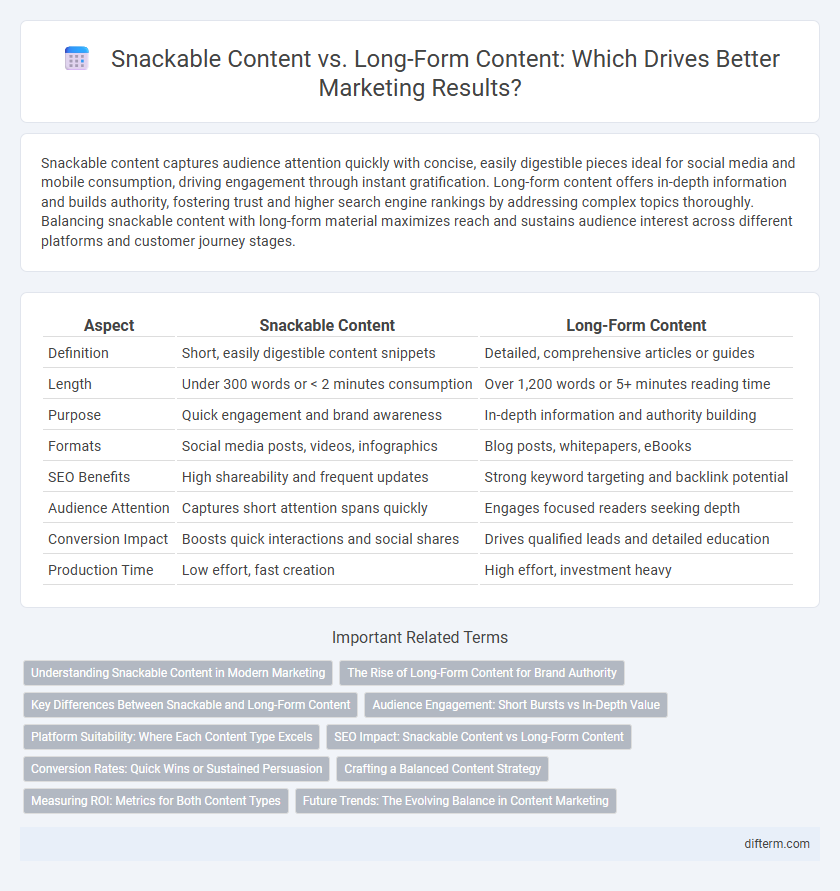Snackable content captures audience attention quickly with concise, easily digestible pieces ideal for social media and mobile consumption, driving engagement through instant gratification. Long-form content offers in-depth information and builds authority, fostering trust and higher search engine rankings by addressing complex topics thoroughly. Balancing snackable content with long-form material maximizes reach and sustains audience interest across different platforms and customer journey stages.
Table of Comparison
| Aspect | Snackable Content | Long-Form Content |
|---|---|---|
| Definition | Short, easily digestible content snippets | Detailed, comprehensive articles or guides |
| Length | Under 300 words or < 2 minutes consumption | Over 1,200 words or 5+ minutes reading time |
| Purpose | Quick engagement and brand awareness | In-depth information and authority building |
| Formats | Social media posts, videos, infographics | Blog posts, whitepapers, eBooks |
| SEO Benefits | High shareability and frequent updates | Strong keyword targeting and backlink potential |
| Audience Attention | Captures short attention spans quickly | Engages focused readers seeking depth |
| Conversion Impact | Boosts quick interactions and social shares | Drives qualified leads and detailed education |
| Production Time | Low effort, fast creation | High effort, investment heavy |
Understanding Snackable Content in Modern Marketing
Snackable content consists of short, easily digestible pieces designed to capture audience attention quickly on social media platforms and mobile devices. It increases engagement through concise messaging, visuals, and shareability, making it ideal for brand awareness and frequent audience touchpoints. Modern marketing leverages snackable content to complement long-form content by driving traffic and enhancing overall content strategy effectiveness.
The Rise of Long-Form Content for Brand Authority
Long-form content has gained traction as a powerful tool for building brand authority by providing in-depth insights and comprehensive information that snackable content often lacks. Brands investing in articles, whitepapers, and detailed guides enhance SEO rankings and foster trust among audiences seeking expertise and value. This strategic emphasis on long-form content supports sustained engagement and reinforces credibility in competitive markets.
Key Differences Between Snackable and Long-Form Content
Snackable content delivers concise, easily digestible information designed for quick engagement on social media and mobile platforms, often under 300 words or 2 minutes of video. Long-form content provides in-depth analysis, comprehensive insights, and detailed storytelling that improves SEO rankings and establishes authority, typically exceeding 1,000 words or 10 minutes of video consumption. Snackable content drives immediate interactions and shareability, while long-form content fosters trust, enhances brand credibility, and supports sustained audience retention.
Audience Engagement: Short Bursts vs In-Depth Value
Snackable content delivers short bursts of information designed to capture attention quickly and boost immediate audience engagement through easily digestible formats like social media posts and infographics. Long-form content provides in-depth value, fostering deeper connections by addressing complex topics and encouraging prolonged interaction through articles, whitepapers, and comprehensive guides. Balancing snackable content for quick engagement with long-form content for sustained interest optimizes overall marketing strategies and audience retention.
Platform Suitability: Where Each Content Type Excels
Snackable content excels on social media platforms like Instagram, TikTok, and Twitter, where audiences prefer quick, easily digestible information that fits short attention spans. Long-form content performs best on websites, blogs, and platforms like LinkedIn and YouTube, where users seek in-depth insights, detailed storytelling, and comprehensive information. Choosing the right format maximizes engagement by aligning content style with platform user behavior and content consumption patterns.
SEO Impact: Snackable Content vs Long-Form Content
Snackable content boosts SEO by increasing engagement through short, digestible pieces that encourage frequent user visits and shares, improving dwell time and reducing bounce rates. Long-form content enhances SEO by providing comprehensive coverage on topics, increasing keyword density and attracting backlinks that signal authority to search engines. Combining both strategies optimizes search rankings by balancing immediate user engagement with in-depth relevance and authority.
Conversion Rates: Quick Wins or Sustained Persuasion
Snackable content drives higher conversion rates through immediate engagement by delivering concise, impactful messages tailored for fast decision-making. Long-form content builds trust and authority over time, fostering sustained persuasion that converts audiences through detailed information and storytelling. Combining both strategies optimizes conversion funnels by targeting quick wins and nurturing long-term customer relationships.
Crafting a Balanced Content Strategy
Effective marketing strategies require balancing snackable content, which offers quick, easily digestible information ideal for social media engagement, with long-form content that provides in-depth insights, fostering authority and SEO benefits. Snackable content boosts brand visibility and user interaction through concise visuals and brief text, while long-form articles enhance audience trust and support lead generation by addressing complex topics thoroughly. Integrating both content types ensures a comprehensive approach that meets diverse audience preferences and maximizes overall content marketing impact.
Measuring ROI: Metrics for Both Content Types
Measuring ROI for snackable content involves tracking engagement metrics such as click-through rates, social shares, and time spent on page, which indicate immediate user interaction and brand visibility. Long-form content ROI is often assessed through lead generation, conversion rates, and search engine rankings, reflecting deeper audience engagement and sustained organic traffic growth. Combining analytics from both content types provides a comprehensive view of marketing effectiveness and supports data-driven strategy optimization.
Future Trends: The Evolving Balance in Content Marketing
Snackable content continues to dominate social media platforms due to shrinking attention spans, driving marketers to create concise, engaging posts optimized for smartphones and quick consumption. However, long-form content remains essential for SEO, thought leadership, and in-depth storytelling, leveraging multimedia elements such as videos, infographics, and interactive features to maintain user engagement. Emerging AI tools and data analytics enable marketers to dynamically tailor the optimal mix of snackable and long-form content based on audience behavior and platform algorithms, signaling a future trend of personalized, adaptive content strategies.
Snackable Content vs Long-Form Content Infographic

 difterm.com
difterm.com